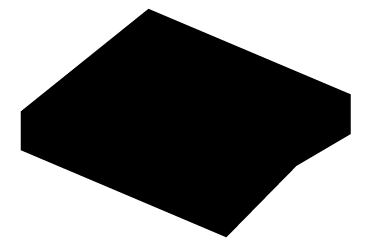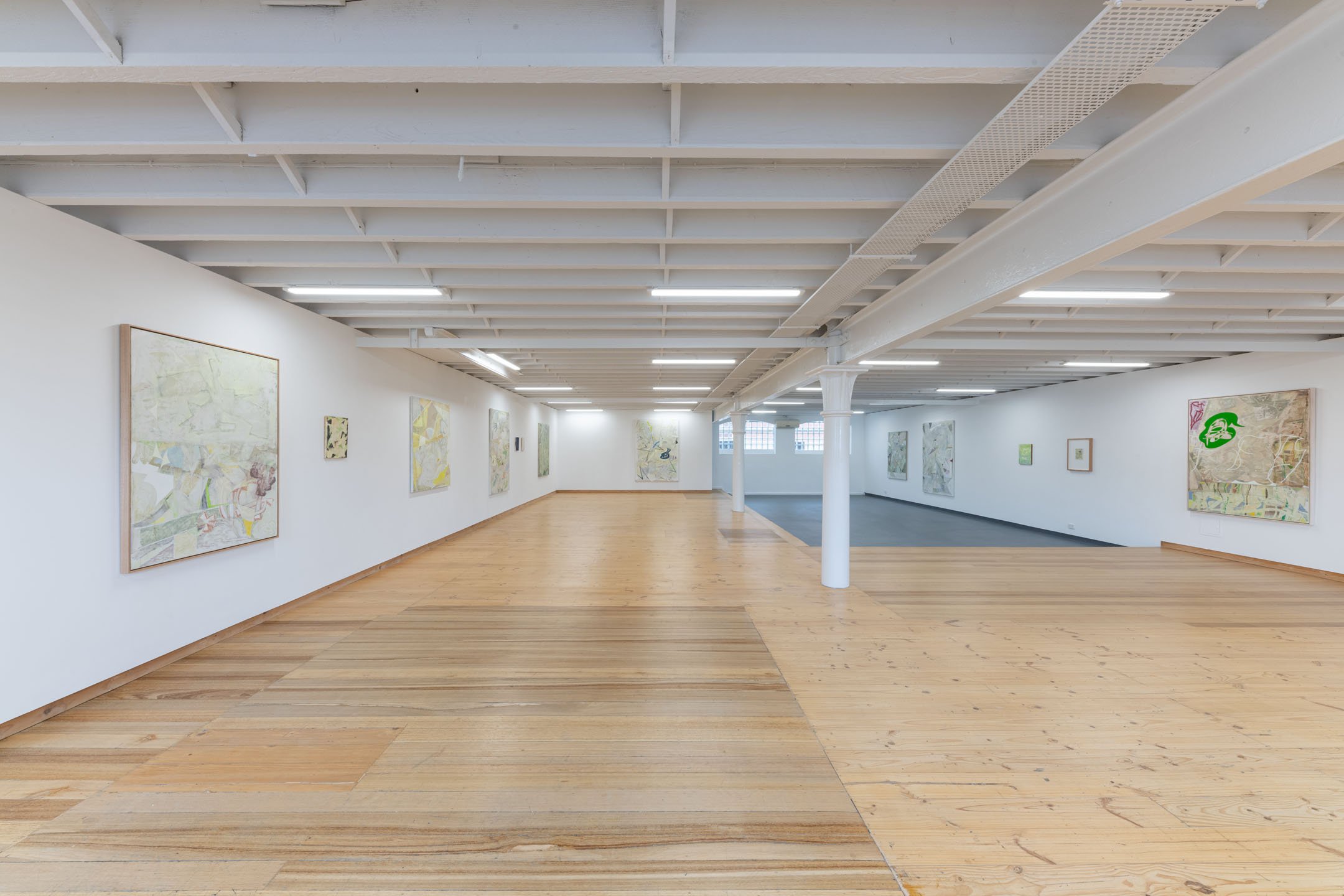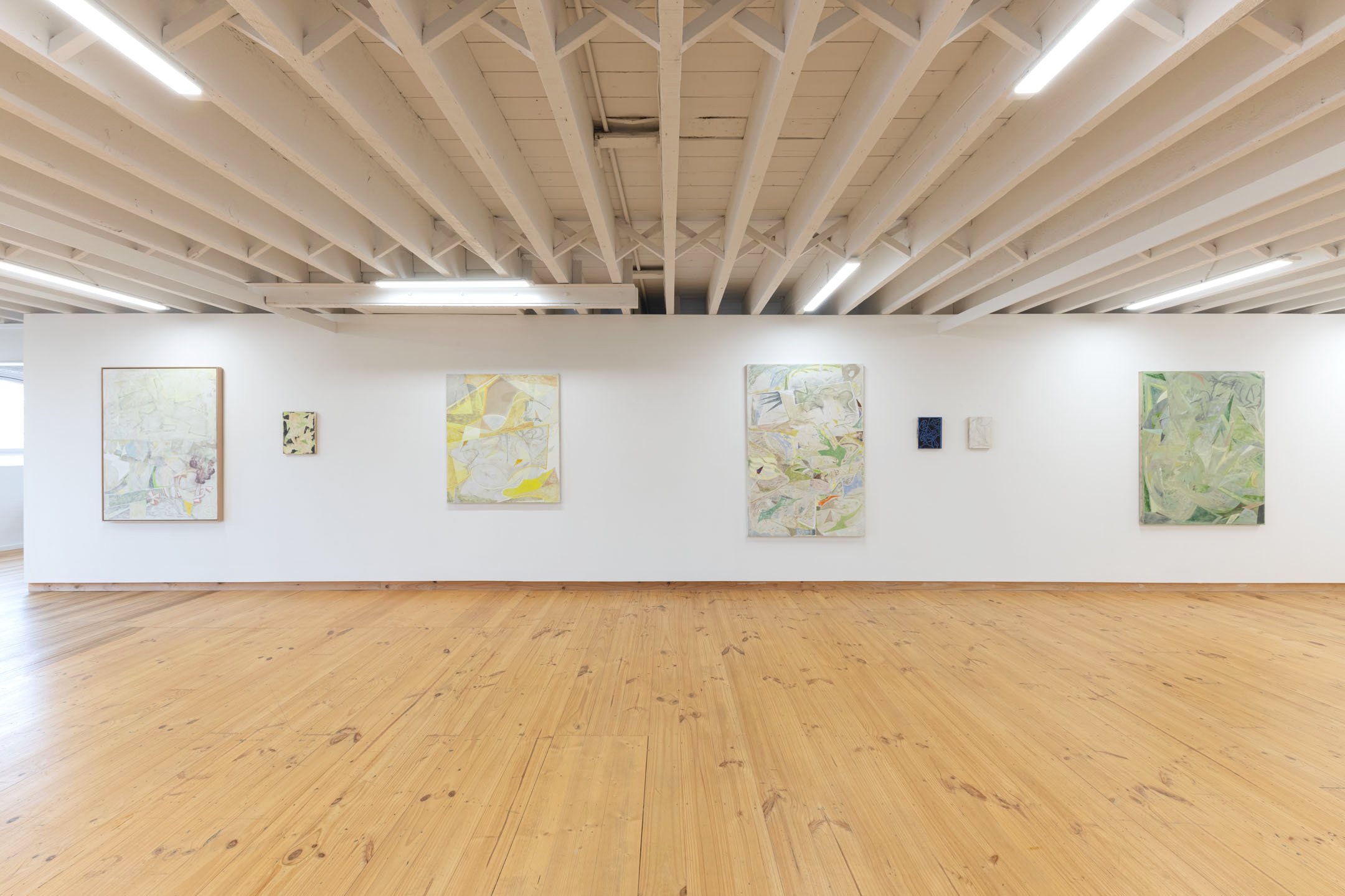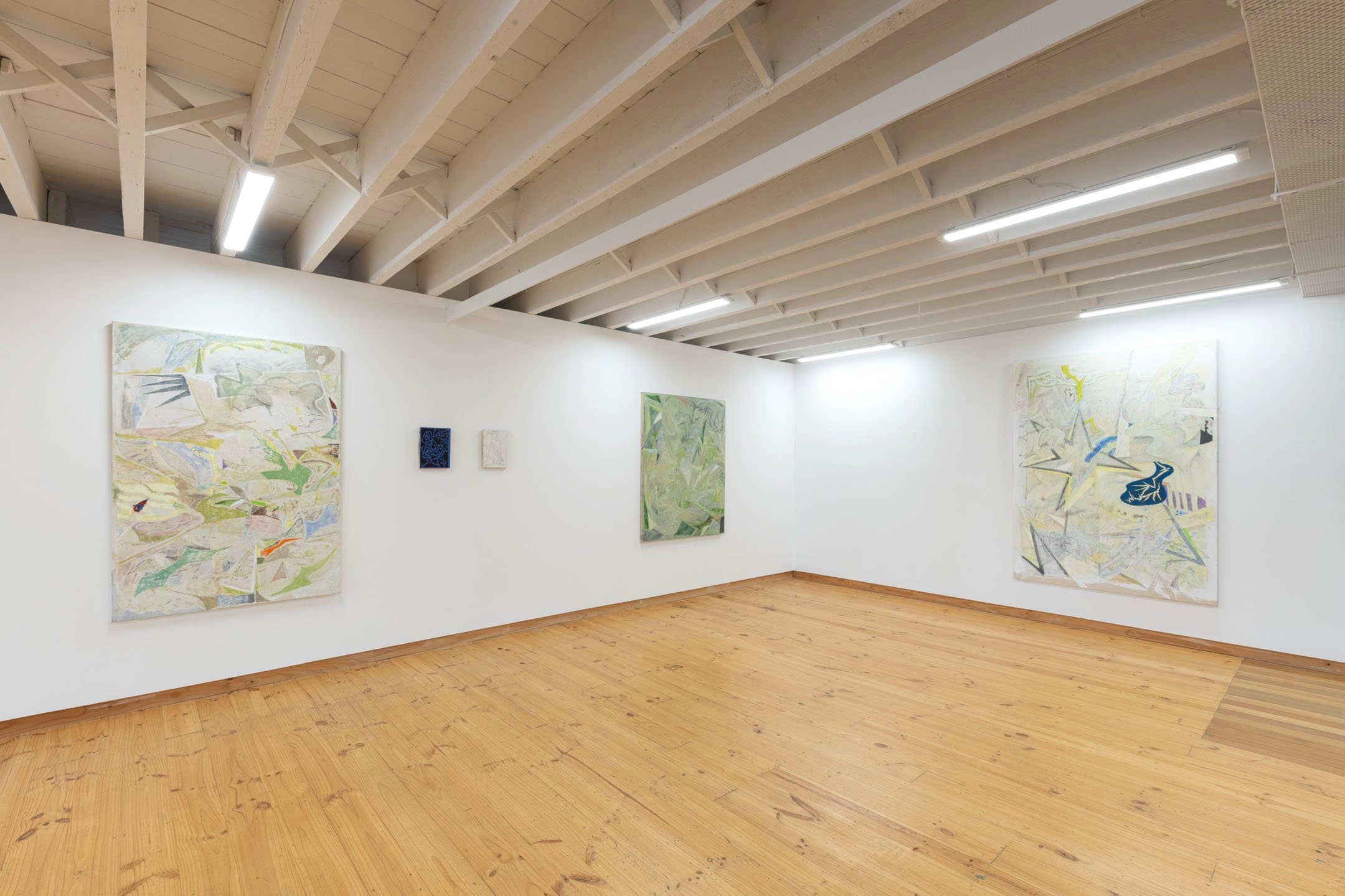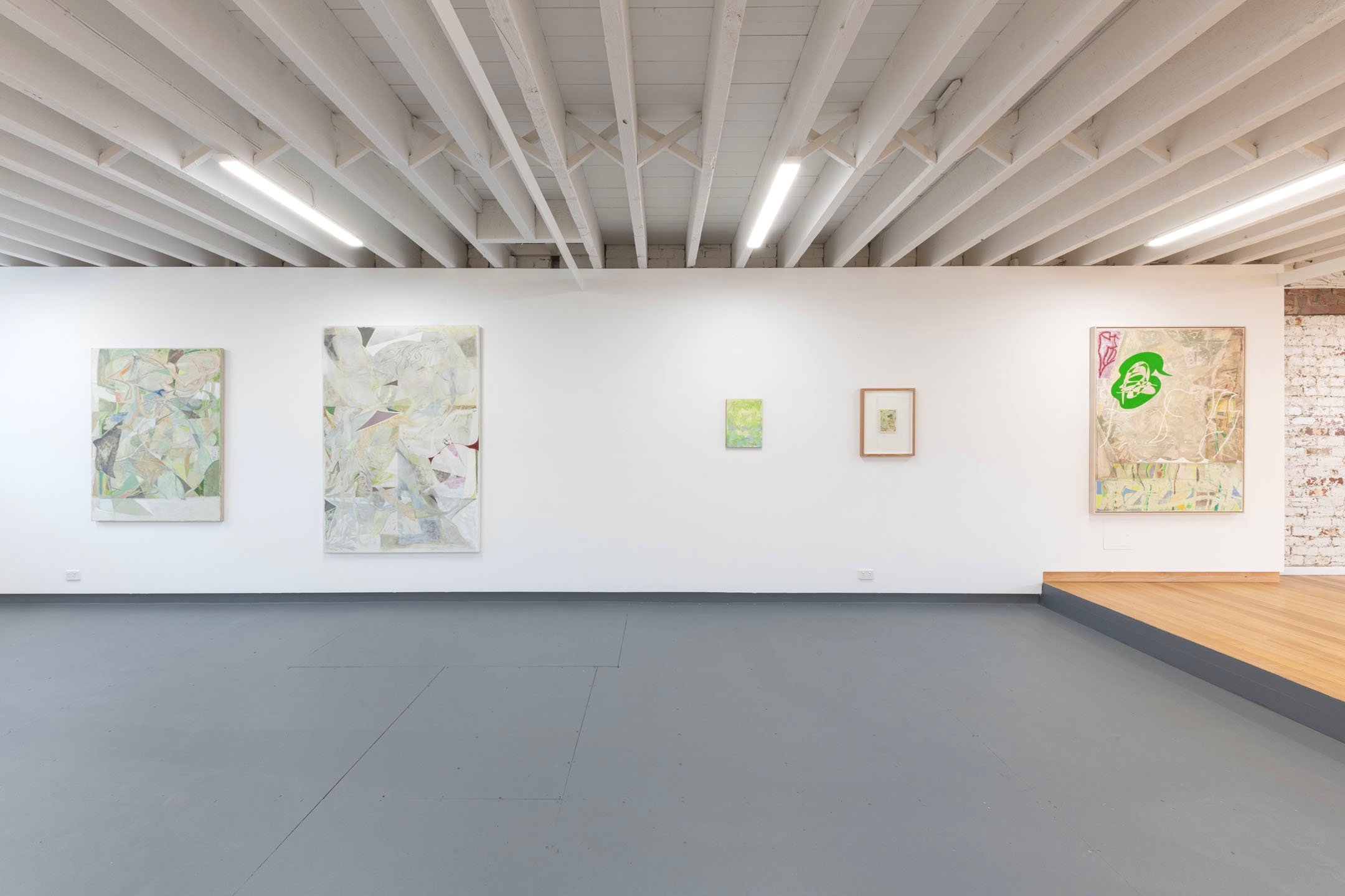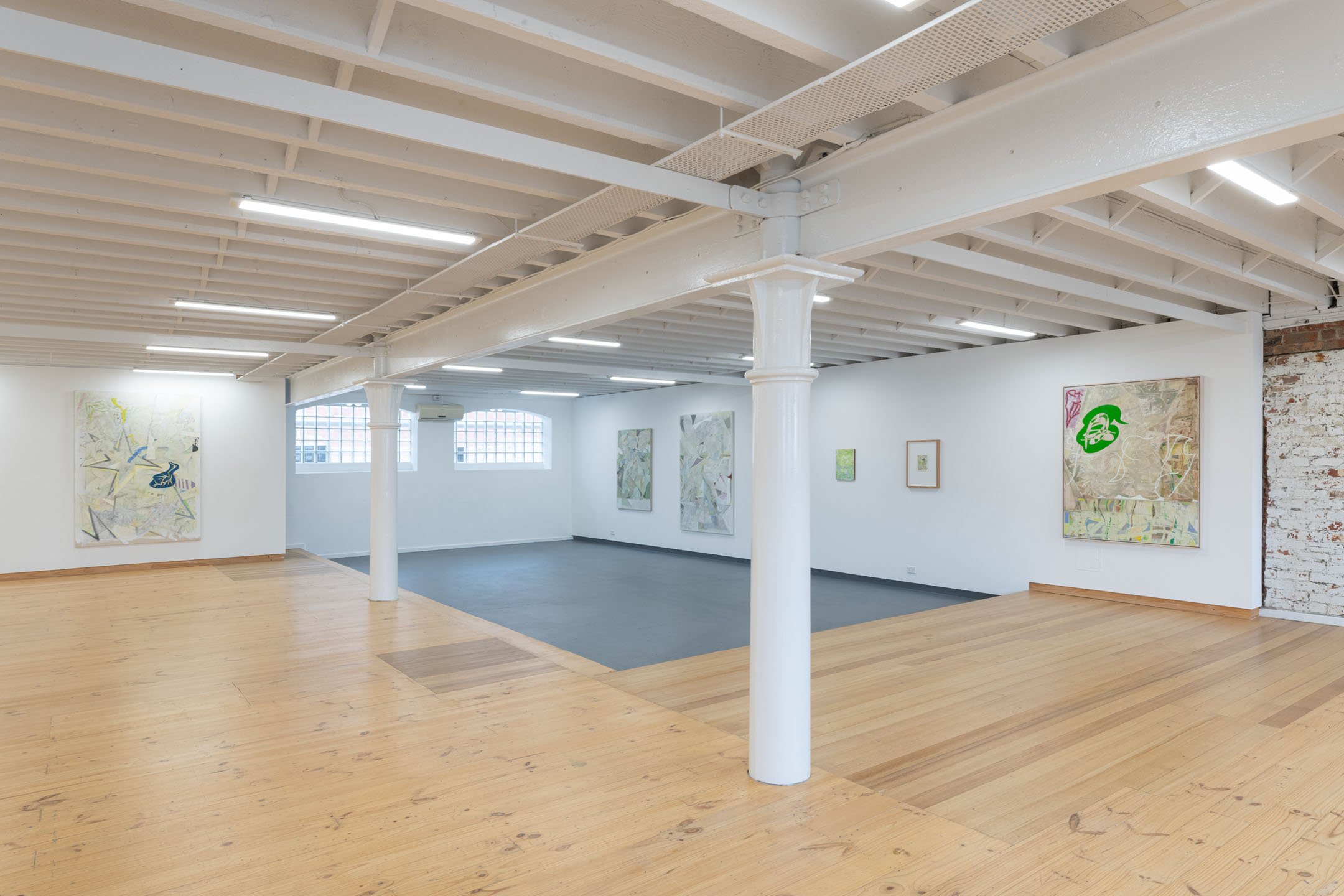JORDAN GRANT: IN THE BEGINNING A STAR, WHEN DRAWN WITH NAIL INTO BRICK, LOOKED AS FOLLOWS
08.12.21-22.01.22
Installation images, Jordan Grant; In The Beginning a Star, when Drawn with Nail into Brick, looked as Follows . Blockprojects, 2021. Photography: Simon Strong
JORDAN GRANT: IN THE BEGINNING A STAR, WHEN DRAWN WITH NAIL INTO BRICK, LOOKED AS FOLLOWS
Spaces of wordless immediacy
Thoughts on the painting practice of Australian artist Jordan Grant for his exhibition: In the beginning a star, when drawn with nail into brick, looked as follows.
Words, symbols, and signs can be unreliable. We like to think that language (written, verbal or aural) can be solid, but of course it’s equally sensory, vague, and general, forming though abstract and figurative idioms. Symbols and signs can seem objective, pointing to actions, objects, places, and atmospheres, but symbols are also subjective, and this influences our interpretation of them. Given this, one might say that meaning, from a semiotic vantage, is to various degrees contingent- a denotation as well as connotation. Language of any sort can never be a transparent tool for representing things, and particularly as it is the central mode through which to express power relationships¹.
Jordan Grant is acutely aware of the functions of language and signs as he makes contact in his paintings with what might best be described as an unfixed space full of emerging or retreating signs- a mixture of visual languages. The imagery appears to hold quauties that represent moments of arrival, where certain signs and shapes or the occasional abstruse word manifest within the work, while other elements seem to be embryonic. The paintings appear at times to have crystalised as a fragile and delicate moment- seemingly to have developed through workings that have simply solidified. At times the forms in his paintings are arcane, frail, delicate, dynamic, scrubby, even cancelled out. Most elements sit on the edge of meaning deferring any real singular clarity, so the paintings seem to be formed through the aim of avoiding lucid representations. They reside within a sensory realm of equivocality, a space that deliberately seems to sidestep being reduced to one thing or another.
In many ways this is in alignment with the notion expressed by art historian T.J. Clark, that elusive painting may be a ‘resistance’ or at least an ethical and political position in relation to the times². Clark’s reflection around elusiveness may indicate a way for painting to avoid being designated, leaving it open to expressing complexity and corresponding contradictions that exist within us, and the world within which we reside. Grant considers the specificity of language, signs, and symbols to be a type of bind between a desire for clarity and the problematic of unintentionally curtailing complex meanings. He seems to have decided that his paintings might just as well sift through unfixed idiosyncratic forms rather than deal with a fate of being classified as something too fixed. And that his ever-changing mutable works might form a valuable intermediary space within which to reflect personally and politically on the feelings of unfolding and ongoing complexities.
The paintings comprise changing transitions, shapes and signs that have been formed through searching and enquiry rather than pre-conception. He confesses to a suspicion around absolute ideas, preferring to escape the definable to arrive at moments of coalescence. This allows for subjectivity to be more at play, rather than tangible principles. He is drawn to French philosopher Jacques Ranciere’s idea of a .. wordless ambivalence in which the same procedures create and retract meaning, ensure and undo the link between perceptions, actions and affects. If there can be such a thing, this is the idea of a language forming visibly as a ‘wordless immediacy’s³.
The paintings communicate more than what we see, as they draw on the idea of our own unconscious mind and its changing moments. We also become aware that, to some degree, the artist has worked through an unconscious cognisance to unify metamorphizing imagery, as well as manage and preserve various fragmentary break-aways. Conversely to the free-flowing forms and shapes, the unification in these paintings is accomplished through analogous colours and reasonably structured compositions that often disclose one space revealing another. There is particularly a revealing or emergent awareness in the compositions where one section of a work may seem to lift, to reveal an interior or back space, evoking the very experience of a painting for the artist as it unfolds and materialises, where things are exposed while sections are layered over The painting’s imageries appear to adapt the idea of ongoing transformation, a type of reflexivity about thinking around making a painting, disclosing the notion that thinking in painting forms through unending constructions and reconstructions.
Theorist James Elkins considers that ‘thinking in painting is thinking as paint’4, where the artist is led by the pre-ordained physiognomies of paint as material. British artist Sonia Boyce refers to this as a ‘post intentionality’ in relation to production, implying that in working with paint an artist may simply assess the direction of a painting via the manner to which the paint unfoldss. In other words, even if determinism regulates an approach to painting, in thinking through painting an artist uncovers open and free actions through the interaction of their conscious/unconscious workings with the material. Paint as a substance is amenable, a resource for multiple ‘becomings’ carrying within it the internal conditions of inventiveness as well as the external limits of constraint. Paint carries within it the indeterminacy of substance as much as it holds energies that form as passages towards the merged implications of mind and matters. This is how, in painting, substances occupy the mind as a series of open and free acts. The experience of paint is always grasped in relation to the moving body, through a reciprocity involving the movement of one’s hand and the movement of material form. In this free- flowing working with paint, visceral combinations arise out of ‘wet into wet’ while subtle touches go together with dry, scabby scrapes and removals, and indeterminant daubs form into elucidations and recognitions within one’s cognisance.
Jordan Grant’s paintings might be considered as alternatives to absolute or definitive ideas in favour of a discourse about how things come about, how we can hold to multiple vantages where the outcome cannot be known, like the imagination. Perhaps the title of his exhibition suggests the difficulty of aiming for something intangible using the paltry tool of paint, the way that language can often be wanting, and earth bound.
Peter Westwood (Dr. Peter Westwood is an academic, artist and researcher living and working in Naarm I Melbourne)
Notes:
1. Foucault, M (1994) The Order of Things, New York: Random House.
2. HockdOrfer, A. and Kroner, T (eds). (2018). Jutta Koether- tour me Madame, Museum Brandhorst Bayerische Staatsgemaldesammlungen, Munich: Cologne: Verlag der Buchhandlung Walther Konig, p.243
3. Ranciere, J (2003) The Future of the Image, New York: Verso Books, p. 5.
4. Elkins, J. (1999) The object stares back: on the nature of seeing. Florida: Harvest, p. 113.
5. Fisher, E. and Fortnum, R. (2013). On the value of not knowing: wonder, beginning again and letting be. London: Black Dog Publishing, p. 78.
6. Coole, D. and Frost, D. (2010), New materia/isms: ontology, agency, and politics. Durham, North Carolina: Duke University Press. Grosz, citing Bergson,p. 150.
